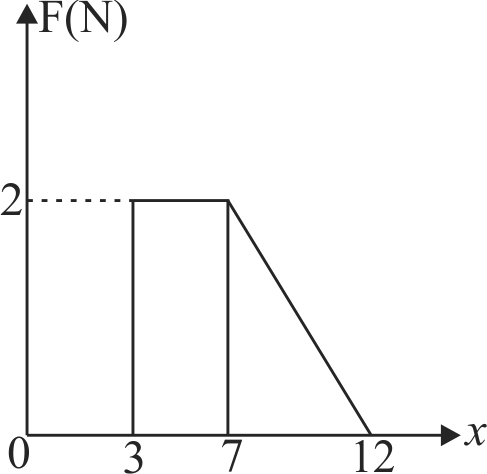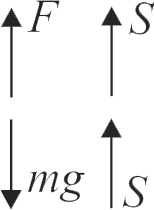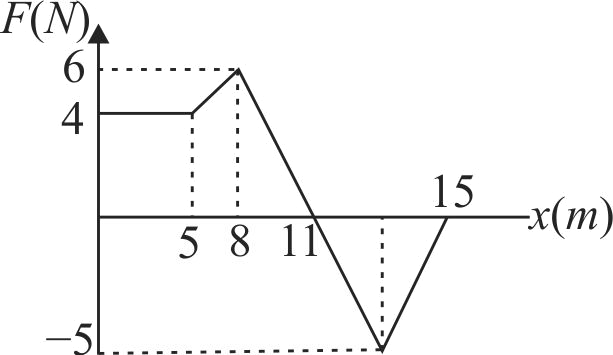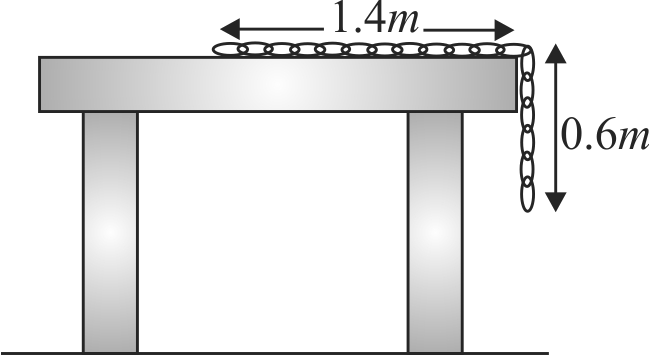355838 A force \(F=-K(y i+x j)\) (where \(K\) is positive constant) acts on a particle moving in the \(x y\) plane. Starting from the origin, the particle is taken along the positive \(x\)-axis to the point \((a, 0)\) and then parallel to the \(y\)-axis to the point \((a, a)\). The total work done by the force \(F\) on the particles is
355840
Identify the correct statement from the following:
I.
Work done by a man in lifting a bucket out of a well by means of a rope tied to the bucket is negative.
II.
Work done by gravitational force in lifting a bucket out of a well by a rope tied to the bucket is negative.
III.
Work done by friction on a body sliding down an inclined plane is positive.
IV.
Work done by an applied force on a body moving on a rough horizontal plane with uniform velocity is zero.
V.
Work done by the air resistance on an oscillating pendulum is negative.
Choose the correct answer from the options given below:
355838 A force \(F=-K(y i+x j)\) (where \(K\) is positive constant) acts on a particle moving in the \(x y\) plane. Starting from the origin, the particle is taken along the positive \(x\)-axis to the point \((a, 0)\) and then parallel to the \(y\)-axis to the point \((a, a)\). The total work done by the force \(F\) on the particles is
355840
Identify the correct statement from the following:
I.
Work done by a man in lifting a bucket out of a well by means of a rope tied to the bucket is negative.
II.
Work done by gravitational force in lifting a bucket out of a well by a rope tied to the bucket is negative.
III.
Work done by friction on a body sliding down an inclined plane is positive.
IV.
Work done by an applied force on a body moving on a rough horizontal plane with uniform velocity is zero.
V.
Work done by the air resistance on an oscillating pendulum is negative.
Choose the correct answer from the options given below:
355838 A force \(F=-K(y i+x j)\) (where \(K\) is positive constant) acts on a particle moving in the \(x y\) plane. Starting from the origin, the particle is taken along the positive \(x\)-axis to the point \((a, 0)\) and then parallel to the \(y\)-axis to the point \((a, a)\). The total work done by the force \(F\) on the particles is
355840
Identify the correct statement from the following:
I.
Work done by a man in lifting a bucket out of a well by means of a rope tied to the bucket is negative.
II.
Work done by gravitational force in lifting a bucket out of a well by a rope tied to the bucket is negative.
III.
Work done by friction on a body sliding down an inclined plane is positive.
IV.
Work done by an applied force on a body moving on a rough horizontal plane with uniform velocity is zero.
V.
Work done by the air resistance on an oscillating pendulum is negative.
Choose the correct answer from the options given below:
355838 A force \(F=-K(y i+x j)\) (where \(K\) is positive constant) acts on a particle moving in the \(x y\) plane. Starting from the origin, the particle is taken along the positive \(x\)-axis to the point \((a, 0)\) and then parallel to the \(y\)-axis to the point \((a, a)\). The total work done by the force \(F\) on the particles is
355840
Identify the correct statement from the following:
I.
Work done by a man in lifting a bucket out of a well by means of a rope tied to the bucket is negative.
II.
Work done by gravitational force in lifting a bucket out of a well by a rope tied to the bucket is negative.
III.
Work done by friction on a body sliding down an inclined plane is positive.
IV.
Work done by an applied force on a body moving on a rough horizontal plane with uniform velocity is zero.
V.
Work done by the air resistance on an oscillating pendulum is negative.
Choose the correct answer from the options given below:
355838 A force \(F=-K(y i+x j)\) (where \(K\) is positive constant) acts on a particle moving in the \(x y\) plane. Starting from the origin, the particle is taken along the positive \(x\)-axis to the point \((a, 0)\) and then parallel to the \(y\)-axis to the point \((a, a)\). The total work done by the force \(F\) on the particles is
355840
Identify the correct statement from the following:
I.
Work done by a man in lifting a bucket out of a well by means of a rope tied to the bucket is negative.
II.
Work done by gravitational force in lifting a bucket out of a well by a rope tied to the bucket is negative.
III.
Work done by friction on a body sliding down an inclined plane is positive.
IV.
Work done by an applied force on a body moving on a rough horizontal plane with uniform velocity is zero.
V.
Work done by the air resistance on an oscillating pendulum is negative.
Choose the correct answer from the options given below:




